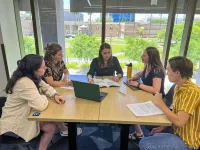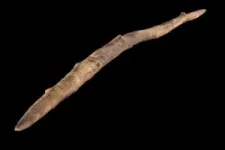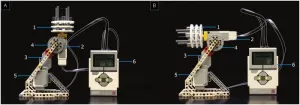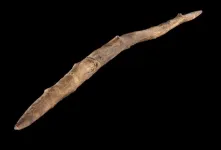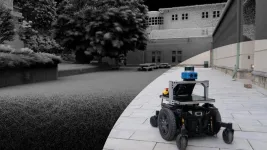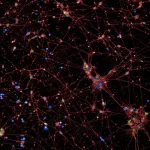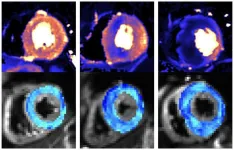(Press-News.org) Women working as STEM instructors are more likely than men in the same profession to disclose to their undergraduate students identities which could carry stigma, such as depression or growing up in a low-income household. In the new study, published July 19, 2023 in the open-access journal PLOS ONE, Carly Busch of Arizona State University, USA, and colleagues suggest that these decisions to disclose may be in order to act as role models for students.
Concealable stigmatized identities (CSIs) are identities that can be hidden and may carry negative stereotypes when revealed. This study investigated how gender might affect the ways science and engineering instructors who hold CSIs navigate teaching.
The authors surveyed science and engineering university instructors teaching undergraduates across the US, with a focus on eight CSIs stigmatized in academic science as well as broader US culture: lesbian, gay, bisexual, and queer (LGBQ+) identities; depression; anxiety; struggling academically; growing up in a low income household; transferring from a 2-year institution; being a first generation college student; and having a disability. They asked instructors to rate each CSI’s perceived stigma, as well as the extent to which they revealed any relevant CSIs to all, some, or none of the students in their last undergraduate class.
Over 2,000 instructors responded to the survey. 38 percent of the responding instructors were women and 58 percent men (other gender identities were excluded from the final analyses). After accounting for race, age, and teaching appointment, women were more likely than men to report having CSIs including depression, anxiety, and having a disability, though less likely to report being a first generation college student or transferring from a community college.
Women had almost 1.5 higher odds than men of revealing CSIs to at least some students—particularly that they had depression, grew up in a low income household, or were first generation college students. Women also rated CSIs, in aggregate as well as individually, as more stigmatized than did men.
Perceiving CSIs as more stigmatizing has been linked to increased concealment behavior in general population settings, in contrast to the current study’s findings. The authors suggest that female science and engineering instructors may be more willing to divulge CSIs to some students in order to act as role models in a space that has been historically unwelcoming to marginalized identities.
Sara Brownell adds: “With concealable stigmatized identities, students will not know whether an instructor could be a role model without that instructor disclosing this information. Women are carrying the burden of revealing and normalizing that one can have these identities and still be successful in science, but also may be opening themselves up to greater bias and stigma.”
Carly Busch adds: “Understanding the differences in how men and women manage their CSI disclosure while teaching undergraduate STEM courses is an important consideration as we learn more about the impact of role models in science on undergraduates, especially those who carry identities which are contrary to the stereotypical scientist. Women and girls who have seen a scientist of the same gender have shown improved outcomes, and this study lays the foundation to explore the impact of role models with invisible identities on students who share the same identity.”
#####
In your coverage please use this URL to provide access to the freely available article in PLOS ONE: https://journals.plos.org/plosone/article?id=10.1371/journal.pone.0287795
Citation: Busch CA, Cooper KM, Brownell SE (2023) Women drive efforts to highlight concealable stigmatized identities in U.S. academic science and engineering. PLoS ONE 18(7): e0287795. https://doi.org/10.1371/journal.pone.0287795
Author Countries: USA
Funding: This work was partially supported by the National Science Foundation awarded to S.E.B. and K.M.C. (NSF; No. 00035931). C.A.B. was supported by the NSF Graduate Research Fellowship under Grant No. 026257-001 and K.M.C was supported by an NSF CAREER award (No. 00037072). Any opinion, findings, and conclusions or recommendations expressed in this material are those of the authors(s) and do not necessarily reflect the views of the National Science Foundation. The funders had no role in study design, data collection and analysis, decision to publish, or preparation of the manuscript.
END
STEM instructors who are women drive disclosure of concealable stigmatized identities to undergraduates
2023-07-19
ELSE PRESS RELEASES FROM THIS DATE:
Researchers used a LEGO robotics kit as a cheap, effective way to purify self-assembling DNA origami
2023-07-19
Article URL: https://journals.plos.org/plosone/article?id=10.1371/journal.pone.0283134
Article Title: Gradient-mixing LEGO robots for purifying DNA origami nanostructures of multiple components by rate-zonal centrifugation
Author Countries: USA
Funding: The research in Hariadi lab was supported by the National Institutes of Health Director’s New Innovator Award (1DP2AI144247), National Science Foundation SemiSynBio II (2027215), and Arizona Biomedical Research Consortium (ADHS17-00007401). The funders had no role in study design, data collection and analysis, decision to publish, or preparation of the manuscript. END ...
A 300,000 year-old double-pointed wooden stick was produced by Middle Pleistocene humans using sophisticated woodworking techniques and was likely used for throwing during hunts
2023-07-19
Article URL: https://journals.plos.org/plosone/article?id=10.1371/journal.pone.0287719
Article Title: A double-pointed wooden throwing stick from Schöningen, Germany: Results and new insights from a multianalytical study
Author Countries: UK, Germany
Funding: T.T. and this project are funded by the Deutsche Forschungsgemeinschaft (DFG, German Research Foundation) – project number 447423357. https://www.dfg.de/. The project is further funded by the Lower Saxony Ministry for Science and Culture, with funds from the Future Lower Saxony Programme of the Volkswagen Foundation – project ...
1 in 5 rabbit owners in the UK report painful or debilitating ear disease in their pet, though it may be under-diagnosed and under-treated, with lop-eared and older rabbits being most at risk
2023-07-19
Article URL: https://journals.plos.org/plosone/article?id=10.1371/journal.pone.0285372
Article Title: Ear health and quality of life in pet rabbits of differing ear conformations: A UK survey of owner-reported signalment risk factors and effects on rabbit welfare and behaviour
Author Countries: UK
Funding: The authors received no specific funding for this work. M.R.D.K included some of this questionnaire in part-fulfilment of her Bachelor of Veterinary Medicine at Royal Veterinary College. ...
CHOP researchers reveal how NSAIDs worsen C. difficile infections
2023-07-19
Philadelphia, July 19, 2023—Why do nonsteroidal anti-inflammatory drugs (NSAIDs) exacerbate gastrointestinal infections by Clostridioides difficile, the leading cause of antibiotic-associated diarrhea worldwide? In a new paperpublished in Science Advances, researchers at Children’s Hospital of Philadelphia (CHOP) have begun to answer that question, showing that NSAIDs disrupt the mitochondria of cells lining the colon, sensitizing them to damage by pathogenic toxins.
Clostridioides ...
Early humans were weapon woodwork experts, study finds
2023-07-19
A 300,000-year-old hunting weapon has shone a new light on early humans as woodworking masters, according to a new study.
State-of-the-art analysis of a double-pointed wooden throwing stick, found in Schöningen in Germany three decades ago, shows it was scraped, seasoned and sanded before being used to kill animals. The research indicates early humans’ woodworking techniques were more developed and sophisticated than previously understood.
The findings, published today (Wednesday, 19 July) in PLOS ONE, also suggest the ...
New therapeutic target for Parkinson’s disease discovered
2023-07-19
· Contacts between lysosomes and mitochondria are broken due to Parkinson’s mutation
· Lysosomes cannot ‘feed’ mitochondria with essential metabolites
CHICAGO --- Northwestern Medicine scientists have uncovered a new mechanism by which mutations in a gene parkin contribute to familial forms of Parkinson's disease. The discovery opens a new avenue for Parkinson’s therapeutics, scientists report in a new study.
The Northwestern scientists discovered that mutations in parkin result in a breakdown ...
Enabling autonomous exploration
2023-07-19
A research group in Carnegie Mellon University's Robotics Institute is creating the next generation of explorers — robots.
The Autonomous Exploration Research Team has developed a suite of robotic systems and planners enabling robots to explore more quickly, probe the darkest corners of unknown environments, and create more accurate and detailed maps. The systems allow robots to do all this autonomously, finding their way and creating a map without human intervention.
"You can set it in any environment, like a department store or a residential building after a disaster, and off it goes," ...
More than just lifestyle and genes: New factor influencing excess body weight discovered
2023-07-19
What determines whether we become overweight? Aside from lifestyle, predisposition plays a role, but genes cannot fully explain the inherited propensity to accumulate excess weight. A new study by Charité – Universitätsmedizin Berlin in Science Translational Medicine* shows that a kind of formatting of the DNA code in one gene that is associated with satiety is implicated in a slightly elevated risk of excess body weight – at least in women. This “epigenetic marking” is established early on during the embryonic stage.
People who are overweight, especially those who ...
Fighting brain cancer
2023-07-19
“Don’t eat me!” That’s how one might translate the signal that the cancer cells in a glioblastoma send to the macrophages (white blood cells specialized in removing dead and dying cellular matter) in the brain. Immunotherapy attempts to enable these cells to eradicate the abnormal cells, but so far, it has met with little success when it comes to glioblastomas.
Researchers led by Professor Gregor Hutter from the Department of Biomedicine at the University and University Hospital Basel have recently used patient data, experiments with mice, and samples from human tumors to study one of these “don’t eat me!” signals and its inhibitory ...
New scanning methods can detect deadly heart condition before symptoms appear
2023-07-19
The research, funded by the British Heart Foundation and published in the journal Circulation, opens the prospect of treating the condition at the earliest stages.
Being able to detect HCM earlier than ever before will also assist trials investigating gene therapies and drug treatments aimed at stopping the disease developing in those at risk.
HCM is an inherited condition that affects around 1 in 500 people in the UK. It causes the muscular walls of the heart to become thicker than normal, affecting how well the heart can pump blood around the body. It is ...
